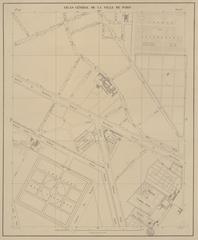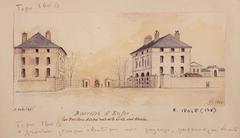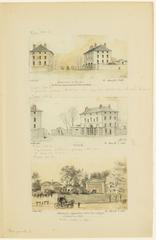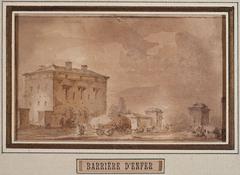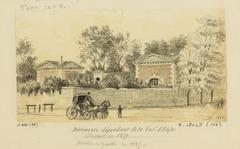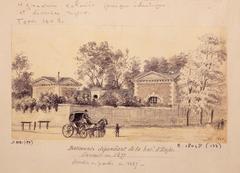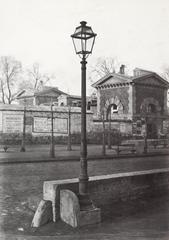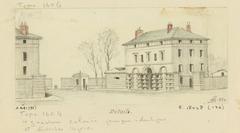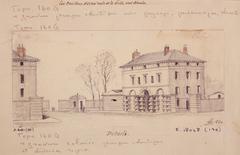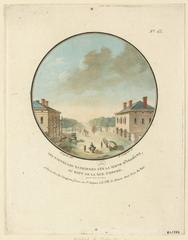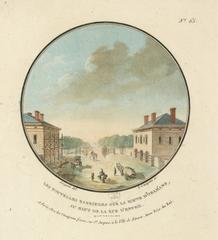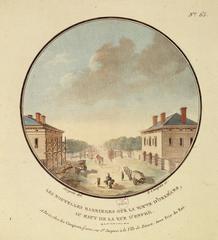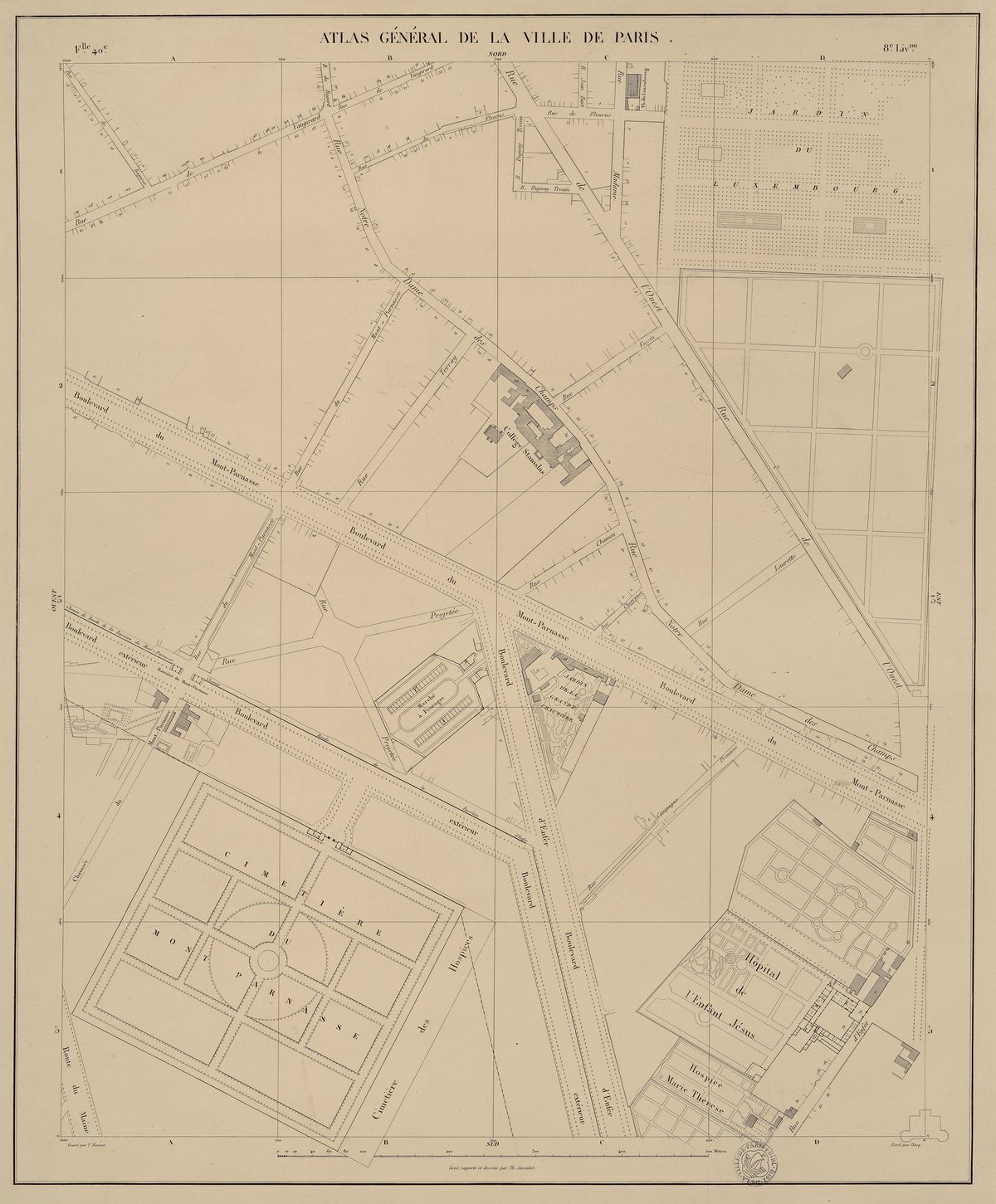
Barrière d’Enfer Paris: Visiting Hours, Tickets, and Historical Significance Guide
Date: 14/06/2025
Introduction: History and Cultural Importance
Situated at the southern gateway of Paris within the lively 14th arrondissement, the Barrière d’Enfer is an enduring monument that exemplifies the city’s neoclassical architectural heritage and intricate historical tapestry. Erected between 1784 and 1791 by Claude Nicolas Ledoux as part of the Wall of the Farmers-General, these twin rotundas were designed not for defense, but to collect octroi taxes on goods entering Paris. The evocative name “Barrière d’Enfer,” or “Barrier of Hell,” originates from the nearby Rue d’Enfer and is closely associated with the mysterious Paris Catacombs, whose entrance lies at one of the pavilions. Today, the Barrière d’Enfer serves as a symbolic portal into Paris’s pre-revolutionary fiscal history, revolutionary social unrest, and urban evolution, as well as the official gateway to one of the city’s most intriguing underground attractions.
This comprehensive guide covers visiting hours, ticketing, accessibility, nearby attractions, and essential travel tips, ensuring an enriching and well-prepared visit. For the latest information, consult authoritative resources like the Paris Catacombs official website and trusted travel guides such as Offbeat France.
Table of Contents
- Introduction
- Origins and Construction
- The Name and Its Symbolism
- Role in the Wall of the Farmers-General
- Connection to the Paris Catacombs
- Architectural and Urban Significance
- Visiting Information: Hours, Tickets, and Accessibility
- Nearby Attractions
- Practical Tips
- Preservation and Visitor Experience
- Frequently Asked Questions (FAQs)
- Conclusion and Recommendations
- Sources
Origins and Construction
The Barrière d’Enfer is among the most notable tollhouses built along the Wall of the Farmers-General, an 18th-century tax wall encircling Paris. Designed by acclaimed architect Claude Nicolas Ledoux, the two identical neoclassical rotundas—marked by Doric columns and balanced proportions—were constructed between 1784 and 1791. These pavilions embodied state authority and Paris’s modernizing ambitions. Unlike traditional city walls, the Barrière d’Enfer was conceived to enforce fiscal boundaries, not military defense.
The Name “Barrière d’Enfer” and Symbolism
Translating to “Barrier of Hell,” the name arises from the nearby Rue d’Enfer, possibly rooted in the Latin “via inferior” (lower road). Over time, the ominous name became intertwined with the Catacombs, amplifying the site’s aura of mystery and intrigue.
Role in the Wall of the Farmers-General
As one of over sixty tollhouses, the Barrière d’Enfer played a crucial role in collecting octroi taxes on goods entering the city—an unpopular measure that heightened social tensions and contributed to the unrest leading up to the French Revolution. While much of the original wall was demolished in the 19th century, these rotundas were preserved as historical monuments and stand today as rare survivors of this era.
Connection to the Paris Catacombs
The Barrière d’Enfer’s northern rotunda serves as the official entrance to the Paris Catacombs—a sprawling underground ossuary developed in the late 18th century to resolve public health problems caused by overcrowded cemeteries. Millions of skeletal remains were transferred into the city’s old limestone quarries, resulting in one of Paris’s most somber and fascinating attractions. The Catacombs’ entrance at 1 Avenue du Colonel Henri Rol-Tanguy is adjacent to the Barrière d’Enfer, making it a pivotal starting point for this unique subterranean journey.
Architectural and Urban Significance
The pavilions of the Barrière d’Enfer represent a pinnacle of Ledoux’s neoclassical vision, with harmonious proportions, Doric colonnades, and sculpted friezes. Their monumental appearance evokes ancient temples and reflects Enlightenment ideals, reinforcing the authority of the state at Paris’s southern threshold. Both pavilions have been protected as historic monuments since 1907.
Visiting Barrière d’Enfer: Hours, Tickets, and Accessibility
Visiting Hours
- Catacombs of Paris:
Open Tuesday to Sunday, 9:45 am – 8:30 pm (last admission at 7:30 pm). Closed on Mondays and selected holidays. - Museums in West Pavilion:
Open Tuesday to Sunday, 10:00 am – 6:00 pm. Closed Mondays.
Always check the official Catacombs website for current schedules.
Tickets
- Catacombs:
Standard adult tickets: ~€29 (as of 2025). Discounts for youth, seniors, and children. Tickets must be booked online in advance due to limited capacity. - Museums:
Free permanent collections; some temporary exhibitions may require a fee. Free for EU residents under 26 and all visitors on the first Sunday of each month.
Accessibility
- The area around Barrière d’Enfer is accessible, with wide sidewalks and public transport connections.
- The Catacombs are not wheelchair accessible due to steep staircases and narrow underground passages.
- Museums offer ramps and elevators for visitors with reduced mobility.
Travel Tips
- Book Catacombs tickets online to guarantee entry.
- Arrive early or late in the day to avoid crowds.
- Wear comfortable shoes; the Catacombs involve uneven ground and 130 steps each way.
- Bring a light jacket for the Catacombs (constant ~14°C/57°F).
- Photography is allowed in the Catacombs without flash; tripods and selfie sticks are prohibited.
Nearby Attractions
- Place Denfert-Rochereau: Home to the Lion of Belfort monument.
- Montparnasse Cemetery: Resting place of many famous figures.
- Parc Montsouris: Ideal for a post-visit stroll.
- Montparnasse Tower: Panoramic city views.
- Theaters and Cafés: Enjoy Parisian culture and cuisine in the surrounding lively district.
Practical Tips for a Smooth Visit
- Use public transportation (Metro Lines 4, 6, or RER B to Denfert-Rochereau) as parking is limited.
- Respect the solemn nature of the Catacombs; do not touch or remove bones.
- The neighborhood is generally safe, but stay alert, especially in crowds.
- Combine your visit with nearby museums, parks, or the Montparnasse area for a full day of exploration.
Preservation and Visitor Experience
The Barrière d’Enfer rotundas stand as preserved monuments, offering insight into Paris’s fiscal, architectural, and social history. Visitors can admire the neoclassical exteriors at any time and access the Catacombs and museums during opening hours. The area is bustling with local life, blending historical significance with the modern vibrancy of the 14th arrondissement.
Frequently Asked Questions (FAQs)
Q: Are tickets for the Catacombs available on-site?
A: Tickets are sold primarily online due to capacity limits; onsite availability is rare.
Q: Is photography allowed inside the Catacombs?
A: Yes, but only without flash. Tripods and selfie sticks are not permitted.
Q: Is the Catacombs visit suitable for children?
A: The Catacombs are not recommended for young children or those with heart, respiratory issues, or claustrophobia. Children under 14 must be accompanied by an adult.
Q: Can I see the Barrière d’Enfer rotundas without entering the Catacombs?
A: Yes, the exteriors are visible and can be admired freely from the square.
Q: Are guided tours available?
A: Yes, guided tours and audio guides are offered for the Catacombs and the museum in the west pavilion.
Conclusion and Visitor Recommendations
A visit to the Barrière d’Enfer offers a profound journey through Parisian history, from Ancien Régime tax policies and revolutionary tensions to wartime resistance and modern cultural life. With its iconic neoclassical architecture, strategic location, and close connection to the Paris Catacombs, it is an essential destination for history enthusiasts and curious travelers. To maximize your experience:
- Book Catacombs tickets in advance.
- Respect the solemnity of this historic and memorial site.
- Embrace guided tours for deeper understanding.
- Explore the vibrant neighborhood for a well-rounded Parisian day.
For up-to-date information, consult the Paris Catacombs official website and recommended guides like Offbeat France.
